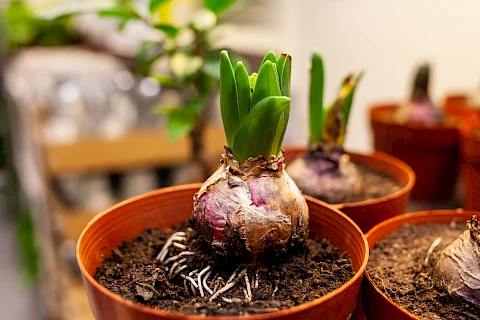
Gardening is a beloved hobby. It's a great way to enjoy the outdoors and connect with nature. However, as wintertime approaches, it becomes necessary to protect your garden. Senior Helpers provides information on winter bulb storage to ensure they'll be ready to replant in spring.
When to Dig Up Bulbous Plants
Timing is everything when it comes to digging up bulbs. The best time to dig up tubers in the Folsom-Granite Bay region is in late fall, usually around late October to early November. You'll know it's time when the foliage turns yellow and begins to die back. It's important not to wait too long, as the first hard frost can come unexpectedly and damage the tubers. Keep an eye on the weather forecast to ensure you choose the right moment based on local conditions.
Preparing to Take out Bulbs
Before you start digging, gather the necessary tools. You'll need a garden fork or trowel, gloves, and a container for the bulbs. Safety should be your top priority, so:
- Make sure to wear sturdy gloves to protect your hands.
- Use tools that are comfortable and easy to handle.
- Avoid overexertion by taking breaks and working slowly.
Water the soil a day before you dig. This softens the ground and makes it easier to lift the bulbs without damaging them.
How to Unearth Crops Safely
When you're ready to dig, use a garden fork or trowel to gently loosen the soil around the tubers. Start a few inches away from the plant to avoid accidentally slicing into the bulb. Lift them carefully and shake off excess soil. Inspect each crop for signs of disease or damage, discarding any that are soft or moldy. Clean off remaining dirt, but avoid washing them, as excess moisture can promote rot during storage.
Storing Tubers for the Frosty Season
Proper winter bulb storage is vital to keeping them healthy for replanting. They should be stored in a cool, dry place with good air circulation. Aim for a temperature between 40-50°F and a humidity level of around 60%. Suitable containers include mesh bags, paper bags, or cardboard boxes. Place them in these containers, ensuring they're not too crowded. Label each type of crop to make replanting easier in the spring.
Tips for Protecting Crops When You Keep Them
Pest prevention is also essential—keep the winter bulb storage area clean and dry to discourage rodents and insects. To prevent mold and rot:
- Avoid storing tubers in plastic bags or sealed containers that trap moisture.
- Check your stored crops periodically for any signs of mold or disease.
- If you find any problems, remove the affected tubers immediately to prevent them from spreading.
Replanting in Spring
The best time to replant your tubers in the region is ideally in early to mid-spring, depending on the bulb type. You need to to prepare the soil by loosening it and adding compost for a nutrient-rich environment. Plant the crops at the proper depth and distance apart, then water them well to encourage growth.
Get Help Enjoying Your Hobbies in the Colder Months
A valuable skill for any senior gardener is learning winter bulb storage. Ensure healthy spring-blooming tubers by following our guide's essential steps.
If you need assistance with your hobbies in the colder months, including help around the house, Senior Helpers Folsom-Granite Bay is here to support you in Folsom, Loomis, Orangevale, Rocklin, and Granite Bay. Contact us to learn more about our senior care services.